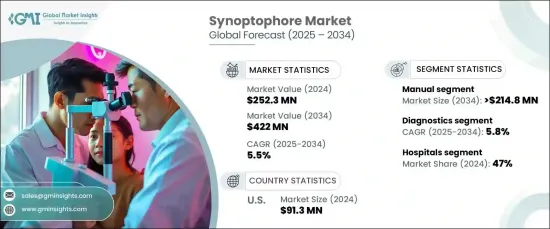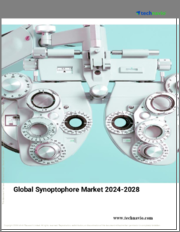
|
시장보고서
상품코드
1665270
시놉토포어 시장 : 시장 기회, 성장 촉진요인, 산업 동향 분석, 예측(2025-2034년)Synoptophore Market Opportunity, Growth Drivers, Industry Trend Analysis, and Forecast 2025 - 2034 |
||||||
세계의 시놉토포어 시장은 2024년에 2억 5,230만 달러로 평가되었고, 2025년부터 2034년까지 CAGR 5.5%로 확대될 전망이며, 안정된 성장률을 경험할 것으로 예측되고 있습니다. 이 시장 성장은 약시나 사시 등 양안시 장애의 유병률 증가로 인한 것이 큽니다. 조기 진단의 중요성에 대한 의식 증가와 비침습적 진단 기술의 지속적인 진보로 시놉토포어 수요는 기세를 늘리고 있습니다. 시놉토포어는 특히 소아 및 안과 의료에서 다양한 시각 장애를 진단하고 치료하는 데 필수적인 도구입니다.

시장은 주로 수동식과 자동식 시놉토포어로 모드별로 구분되고, 수동식이 계속해서 큰 수익 공헌자가 될 것으로 예상되고 있습니다. 2034년까지 이 부문은 2억 1,480만 달러에 이를 전망이며, CAGR 5%로 성장할 것으로 예상됩니다. 수동식 시놉토포어는 합리적인 가격, 신뢰성, 사용 편의성으로 지원됩니다. 이러한 장비는 비용 효율적인 솔루션을 제공하므로 특히 소규모 의료 시설 및 예산에 제약이 있는 지역에 적합합니다. 간단하고 효율적인 설계로 의료 종사자는 시력 검사를 통해 더 큰 통제를 할 수 있으며 복잡한 시력 장애를 해결하는 데 매우 효과적입니다. 수동식 시놉토포어가 계속해서 선호되고 있는 것은 선진적 전문지식을 필요로 하지 않는 사용자 친화적인 조작성에 의합니다.
| 시장 범위 | |
|---|---|
| 시작 연도 | 2024년 |
| 예측 연도 | 2025-2034년 |
| 시작 금액 | 2억 5,230만 달러 |
| 예측 금액 | 4억 2,200만 달러 |
| CAGR | 5.5% |
시놉토포어 시장은 최종 용도의 관점에서 병원, 안과 센터 및 기타 의료 시설로 나뉩니다. 2024년에는 병원이 47%의 압도적인 점유율로 시장을 선도했으며, 예측 기간 동안에도 이 최고 자리를 유지할 것으로 예상됩니다. 병원은 최첨단 진단 장비에 투자하고 대량의 환자를 취급할 수 있기 때문에 시놉토포어의 주요 사용자입니다. 이러한 시설은 정밀 진단과 종합적인 치료 개입에 필요한 인프라를 갖추고 있으며 시력 회복에 중요한 역할을 합니다. 진단 정밀도의 향상과 환자 케어에 대한 주목의 고조가, 병원 안과에서의 시놉토포어 채용 확대를 뒷받침하고 있습니다.
미국의 시놉토포어 시장은 2024년에 9,130만 달러로 평가되었고, 2025년부터 2034년까지 CAGR 5%로 성장할 것으로 예상되고 있습니다. 약시와 사시 비율의 상승과 함께 시각 건강에 대한 의식이 높아지고 있는 것이 이 지역 시놉토포어 수요에 박차를 가하고 있습니다. 또한, 시놉토포어에 디지털 기능을 통합하는 등의 기술 진보가 진단 정확도를 높이고 치료 성과를 향상시키고 있습니다. 이러한 장치는 시력 정렬 문제를 조기에 파악하는 데 매우 중요하며 적시 개입을 가능하게 하여 환자의 예후 개선을 초래합니다.
목차
제1장 조사 방법 및 조사 범위
제2장 주요 요약
제3장 산업 인사이트
- 생태계 분석
- 산업에 미치는 영향요인
- 성장 촉진요인
- 자동화 및 디지털화된 시놉토포아의 진보
- 의료 지출 증가 및 안과 의료 인프라 개선
- 약시나 사시 등 양안시 장애 유병률 증가
- 산업의 잠재적 리스크 및 과제
- 시놉토포아를 효과적으로 조작하는 숙련된 전문가의 필요성
- 성장 촉진요인
- 성장 가능성 분석
- 규제 상황
- 기술 전망
- 갭 분석
- Porter's Five Forces 분석
- PESTEL 분석
- 향후 시장 동향
- 밸류체인 분석
제4장 경쟁 구도
- 서문
- 기업 매트릭스 분석
- 기업 점유율 분석
- 주요 시장 진출기업의 경쟁 분석
- 경쟁 포지셔닝 매트릭스
- 전략 대시보드
제5장 시장 추정 및 예측 : 모드별(2021-2034년)
- 주요 동향
- 수동
- 자동
제6장 시장 추정 및 예측 : 용도별(2021-2034년)
- 주요 동향
- 진단
- 치료
- 하이브리드
제7장 시장 추정 및 예측 : 최종 용도별(2021-2034년)
- 주요 동향
- 병원
- 안과 센터
- 기타
제8장 시장 추정 및 예측 : 지역별(2021-2034년)
- 주요 동향
- 북미
- 미국
- 캐나다
- 유럽
- 독일
- 영국
- 프랑스
- 스페인
- 이탈리아
- 네덜란드
- 아시아태평양
- 중국
- 일본
- 인도
- 호주
- 한국
- 라틴아메리카
- 브라질
- 멕시코
- 아르헨티나
- 중동 및 아프리카
- 남아프리카
- 사우디아라비아
- 아랍에미리트(UAE)
제9장 기업 프로파일
- APPASAMY ASSOCIATES
- DEVINE MEDITECH
- GEM OPTICAL
- HAAG-STREIT
- REDSUN
- NAUGRA
- Roslane Meditech
- Vowish Optical
- 66 Vision-Tech
- YTS Pharmaceuticals
The Global Synoptophore Market was valued at USD 252.3 million in 2024 and is projected to experience a steady growth rate, expanding at a compound annual growth rate (CAGR) of 5.5% from 2025 to 2034. This market growth is largely driven by the increasing prevalence of binocular vision disorders such as amblyopia and strabismus. With rising awareness about the importance of early diagnosis, along with continuous advancements in non-invasive diagnostic technologies, the demand for synoptophores is gaining momentum. These devices are becoming indispensable tools in the diagnosis and treatment of various visual impairments, particularly within pediatric and ophthalmic care.

The market is primarily segmented by mode into manual and automatic synoptophores, with the manual segment expected to remain a significant revenue contributor. By 2034, this segment is projected to reach USD 214.8 million, growing at a CAGR of 5%. Manual synoptophores are favored for their affordability, reliability, and ease of use. These devices offer a cost-effective solution, making them particularly suitable for smaller healthcare facilities or regions with budget constraints. Their simple yet efficient design allows healthcare professionals to have greater control during visual examinations, making them highly effective for addressing complex vision disorders. The continued preference for manual synoptophores is also due to their user-friendly operation, which does not require advanced technical expertise.
| Market Scope | |
|---|---|
| Start Year | 2024 |
| Forecast Year | 2025-2034 |
| Start Value | $252.3 Million |
| Forecast Value | $422 Million |
| CAGR | 5.5% |
In terms of end use, the synoptophore market is divided into hospitals, ophthalmic centers, and other healthcare facilities. In 2024, hospitals led the market with a dominant share of 47% and are expected to maintain this leading position throughout the forecast period. Hospitals are major users of synoptophores due to their ability to invest in state-of-the-art diagnostic equipment and handle large patient volumes. These facilities are equipped with the infrastructure necessary for precise diagnostics and comprehensive therapeutic interventions, playing a critical role in vision rehabilitation. The growing focus on enhancing diagnostic accuracy and patient care is driving the increased adoption of synoptophores within hospital ophthalmology departments.
In the U.S., the synoptophore market was valued at USD 91.3 million in 2024 and is expected to grow at a CAGR of 5% from 2025 to 2034. Increasing awareness about visual health, coupled with the rising rates of amblyopia and strabismus, is fueling the demand for synoptophores in the region. Moreover, technological advancements, including the integration of digital features into synoptophores, are boosting diagnostic precision and improving treatment outcomes. These devices are crucial for the early identification of vision alignment issues, allowing for timely intervention that leads to better patient outcomes.
Table of Contents
Chapter 1 Methodology and Scope
- 1.1 Market scope and definitions
- 1.2 Research design
- 1.2.1 Research approach
- 1.2.2 Data collection methods
- 1.3 Base estimates and calculations
- 1.3.1 Base year calculation
- 1.3.2 Key trends for market estimation
- 1.4 Forecast model
- 1.5 Primary research and validation
- 1.5.1 Primary sources
- 1.5.2 Data mining sources
Chapter 2 Executive Summary
- 2.1 Industry 3600 synopsis
Chapter 3 Industry Insights
- 3.1 Industry ecosystem analysis
- 3.2 Industry impact forces
- 3.2.1 Growth drivers
- 3.2.1.1 Advancements in automated and digital synoptophores
- 3.2.1.2 Increasing healthcare spending and improved eye care infrastructure
- 3.2.1.3 Growing prevalence of binocular vision disorders like amblyopia and strabismus
- 3.2.2 Industry pitfalls and challenges
- 3.2.2.1 Need for skilled professionals to operate synoptophores effectively
- 3.2.1 Growth drivers
- 3.3 Growth potential analysis
- 3.4 Regulatory landscape
- 3.5 Technology landscape
- 3.6 Gap analysis
- 3.7 Porter's analysis
- 3.8 PESTEL analysis
- 3.9 Future market trends
- 3.10 Value chain analysis
Chapter 4 Competitive Landscape, 2024
- 4.1 Introduction
- 4.2 Company matrix analysis
- 4.3 Company market share analysis
- 4.4 Competitive analysis of major market players
- 4.5 Competitive positioning matrix
- 4.6 Strategy dashboard
Chapter 5 Market Estimates and Forecast, By Mode, 2021 – 2034 ($ Mn)
- 5.1 Key trends
- 5.2 Manual
- 5.3 Automatic
Chapter 6 Market Estimates and Forecast, By Application, 2021 – 2034 ($ Mn)
- 6.1 Key trends
- 6.2 Diagnostics
- 6.3 Therapeutics
- 6.4 Hybrid
Chapter 7 Market Estimates and Forecast, By End Use, 2021 – 2034 ($ Mn)
- 7.1 Key trends
- 7.2 Hospitals
- 7.3 Ophthalmic centers
- 7.4 Other end users
Chapter 8 Market Estimates and Forecast, By Region, 2021 – 2034 ($ Mn)
- 8.1 Key trends
- 8.2 North America
- 8.2.1 U.S.
- 8.2.2 Canada
- 8.3 Europe
- 8.3.1 Germany
- 8.3.2 UK
- 8.3.3 France
- 8.3.4 Spain
- 8.3.5 Italy
- 8.3.6 Netherlands
- 8.4 Asia Pacific
- 8.4.1 China
- 8.4.2 Japan
- 8.4.3 India
- 8.4.4 Australia
- 8.4.5 South Korea
- 8.5 Latin America
- 8.5.1 Brazil
- 8.5.2 Mexico
- 8.5.3 Argentina
- 8.6 Middle East and Africa
- 8.6.1 South Africa
- 8.6.2 Saudi Arabia
- 8.6.3 UAE
Chapter 9 Company Profiles
- 9.1 APPASAMY ASSOCIATES
- 9.2 DEVINE MEDITECH
- 9.3 GEM OPTICAL
- 9.4 HAAG-STREIT
- 9.5 REDSUN
- 9.6 NAUGRA
- 9.7 Roslane Meditech
- 9.8 Vowish Optical
- 9.9 66 Vision-Tech
- 9.10 YTS Pharmaceuticals














